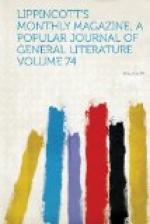Charles and his wife [together]. We shall never forget her kindness, sir.
Nokes. Mind you don’t, then. For, you see, it’s to her own disadvantage, since when I die—and supposing I have forgiven you—the child that has to grow will inherit everything, and Susan only have a life-interest in it.
Charles [hopefully]. I don’t see that, sir. Why shouldn’t you have children of your own?
Nokes [complacently]. True, true. Why shouldn’t we? I didn’t like to dwell upon the idea before, but why shouldn’t we? At all events, Susan [comes forward with Susan], I am sure I shall never repent having shot at the pigeon—I mean, having wooed the Montmorenci, but won THE SUBSTITUTE.
JAMES PAYN.
NEW YORK LIBRARIES
New York has been accused of being purely commercial in tone, and there was a period in her history when she must have pleaded guilty to the indictment. That day, however, is past: she has now many interests—scientific, artistic, literary, musical—as influential as that mentioned, though not perhaps numerically so important. Of the fine arts the city is the acknowledged New World centre, and it is fast forming a literary circle as noteworthy as that of any other capital. The latter owes its existence in part, no doubt, to the great publishing-houses, but has been attracted chiefly by the facilities for research afforded by those great storehouses of learning, the city libraries. Few old residents are aware of the literary wealth stored in these depositories, or of the extent to which they are consulted by scholars and by writers generally.
There are four large libraries in the city whose interest is almost purely literary,—the Society, the Astor, the Lenox, and the Historical Society’s,—one both literary and popular,—the Mercantile,—one interesting as being the outcome of a great trades’ guild,—the Apprentices’,—and one purely popular,—the Free Circulating Library. There are others, of course, but the above are such as from their character and history seem best calculated for treatment in a magazine paper. The oldest of these is the Society Library, which is located in its own commodious fire-proof building at No. 67 University Place. This library is perhaps the oldest in the United States: its origin dates back to the year 1700, when, Lord Bellamont being governor and New York a police-precinct of five thousand inhabitants, the worthy burghers founded the Public Library. For many years it seems to have flourished in the slow, dignified way peculiar to Knickerbocker institutions. In 1729 it received an accession in the library of the Rev. Dr. Millington, rector of Newington, England, which was bequeathed to the Society for the Propagation of the Gospel in Foreign Parts, and by it transferred to the New York Public Library. The institution remained under the care of the city until 1754, when




